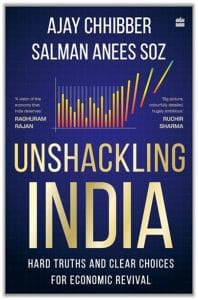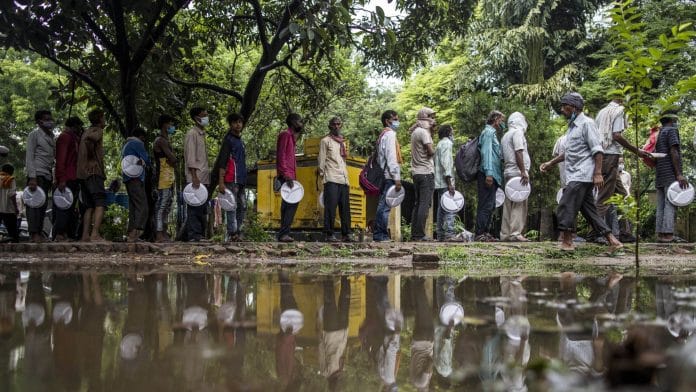India is becoming a welfare state before becoming a developed state—but it even does welfare badly. The compulsions of its democratic system have forced it to address the problems of poverty with subsidies rather than more long-term sustainable solutions. As a result, India now spends almost 4 per cent of GDP on subsidies (almost as much as it spends on public education and health) but also delivers them in a very ineffective manner with high leakages. Again, the contrast with China is striking. China has addressed poverty by creating jobs and providing basic services—health, education, sanitation—and not through subsidies.
Even those emerging market economies that use subsidies have shifted away from product-based subsidies (food, fuel, fertilizer and so on) to more people-based subsidies (cash transfers) to reduce costs and provide the poor more flexibility in their decision- making. India must move in this direction, reduce its subsidy bill, and release more resources for health, education, water and sanitation. Despite its significant costs, India’s welfare system is neither comprehensive nor very effective: subject to huge leakages and corruption, and not well-knit into a coordinated whole.
Subsidies on the three Fs alone—food, fuel and fertilizer— cost 2.5 per cent of GDP, greater than the sum assigned to all development schemes. In the 1960s and ’70s, when India had mass poverty, subsidizing products such as food or fuel made some sense; but today, when poverty has declined, product-based subsidies also benefit the non-poor and distort markets. We need to move away from product- to portable people-based subsidies, especially also as India will witness 300 million migrants over the next fifteen years, who must be able to get subsidies if they are eligible where they live rather than where they come from. Cash transfers have proven to be the best delivery option to reduce costs all over the world, through better targeting without diluting benefits.
Also read: India’s State institutions are failing citizens because they were built to control, not govern
A study by the NCAER found that in 2005, the Public Distribution System (PDS) cost Rs 3-4 to deliver Re 1 of subsidy.25 There are two parts to this cost coming from problems at the fair price shops (FPSs)—where leakages (outright corruption) were abundant—and from widespread mistargeting errors (due to an outdated ration card system based on household surveys carried out in 1993-94). A subsequent evaluation carried out by NCAER (2016) showed some improvements, especially as the ration cards were updated and Type I (exclusion errors) were reduced.26 Despite all its faults, the PDS became a lifesaver for the poor and migrant population. During the pandemic and now, due to the plight of the migrants after the pandemic, a One Nation One Ration Card system has been rolled-out. But this will only increase, not reduce, leakages and corruption as hapless migrants are denied rations in places where they have very limited connections and standing.
But the bigger problem and second cost lies in the operations of the Food Corporation of India (FCI) which procures, stores and moves grain from surplus to deficit states, and does all this very badly. The costs of this operation are very high. Fixing the FCI may be one solution but doing away with it altogether must also be an option.
One bold solution would be to shift not only to cash transfers on the consumer side but also on the producer side, as in Mexico and in Turkey.27 The Pradhan Mantri Kisan Samman Nidhi (PM Kisan) scheme is a start and could be expanded if all other producer and input subsidies were done away with. This would allow the government to collapse fertilizer and all other input subsidies into a cash subsidy, allow the private movement of grain from surplus to deficit states, with the government buying small quantities needed for its strategic reserve. Public stocks would decline from the current level of 80 million tonnes to around 20 million tonnes, with huge fiscal savings. The entire food market would shift out of government hands into private hands. Several emerging economies such as Mexico and Turkey have made such a switch with savings of around 60 per cent. For those concerned about such a sudden shift, transition arrangements could be made with the shift to cash transfers occurring first in urban areas and even by keeping ration shops only for below poverty line (BPL) households for a while.
India cannot afford to rely only on western-style welfare. It runs one of the world’s largest ‘workfare’ (cash-for-work) programmes, the MGNREGA scheme—but with mixed success, and implementation problems. Part of the problem for effective implementation of MGNREGA is that there are at least eighteen other uncoordinated schemes that deal with rural and land development. Moreover, the MGNREGA scheme itself is overly complicated as it has seven stated objectives—so it’s difficult to measure success, especially as none of these seven have any clear yardstick for success. Even the basic objective of 100 days of employment is not based on any assessment of needs. Some states may need 50 days, and others may need as many as 150.
Ironically, developed states with better administration have made greater use of these schemes than the needier backward states, widening further the gap between them—the opposite of what one would expect for a scheme designed to help the genuinely needy. The assets created have not been durable and their creation is not consciously linked to any district- or block- level development plan. In 2013-14, it cost Rs 175 to deliver Rs 132 of wages, of which about Rs 90 went to beneficiaries (using a leakage rate of 30 per cent).28 But if no sustainable assets are created, it is better to shift to a simple cash transfer to help the beneficiaries and save money.
Also read: Socialists vs conservatives harmed Indian education. Bahujans need market forces
Since 2018, MGNREGA work has been allowed on private small farms of backward communities, which has helped improve land productivity and its employment potential by enabling the shift from traditional cereals to more lucrative cash crops, vegetables and fruit. But these remain a very small part of the total scheme so far. MGNREGA work has been allowed for building toilets—but that diffused its core objectives even further and has now fortunately been stopped.
Health-related schemes also need significant review and rationalization. Of India’s Millennium Development Goals for 2015, it is furthest behind in maternal and infant mortality (and neo-natal mortality). Despite so many schemes, ‘out of pocket’ expenses on health, at 63 per cent, are the highest in the world. But in health, cash transfers are not the best answer, as shown by the poor experience with Janani Suraksha Yojana. Better results are being achieved by the recently introduced Janani Shishu Suraksha Karyakram (JSSK), which is a cashless scheme designed to provide a combined package for the mother and child from seven months of pregnancy to one month after pregnancy. It has helped reduce the maternal mortality rate as well as the neo-natal mortality rate. The Ayushman Bharat scheme, which provides health insurance, had a start with ten million beneficiaries in its first year but it should not be an alternative to a functioning health system without which over a billion people are left at the mercy of unregulated private providers. The scheme is in poor shape due to the pandemic and will need a reboot in future years.
India clearly needs reforms to unshackle the economic system from state controls, reduce the footprint of the state so that the government’s slogan of ‘maximum governance; minimal government’ can be realized.
AJAY CHHIBBER is Distinguished Visiting Scholar, Institute for International Economic Policy, George Washington University and Non-Resident Senior Fellow at the Atlantic Council. He was the first Director General, Independent Evaluation Office, India, and Distinguished Visiting Professor at the NIPFP. He served as Assistant Secretary General, UN, and Assistant Administrator, UNDP.
SALMAN ANEES SOZ is an economic development consultant, author and commentator. He has extensive international experience across a range of economic development issues. Formerly with the World Bank, he now serves as a consultant to international institutions.
 This excerpt from ‘Unshackling India: Hard Truths and Clear Choices for Economic Revival’ by Ajay Chhibber and Salman Anees Soz has been published with permission from HarperCollins India.
This excerpt from ‘Unshackling India: Hard Truths and Clear Choices for Economic Revival’ by Ajay Chhibber and Salman Anees Soz has been published with permission from HarperCollins India.






